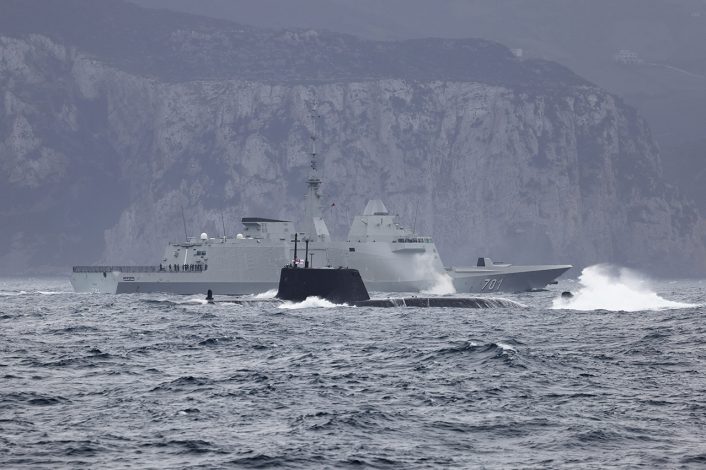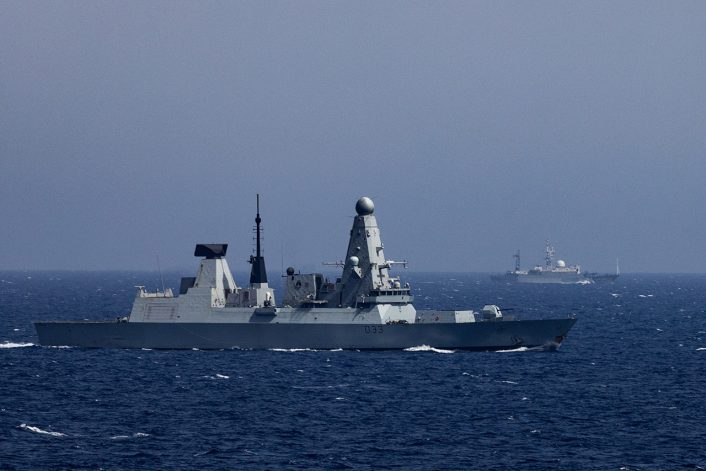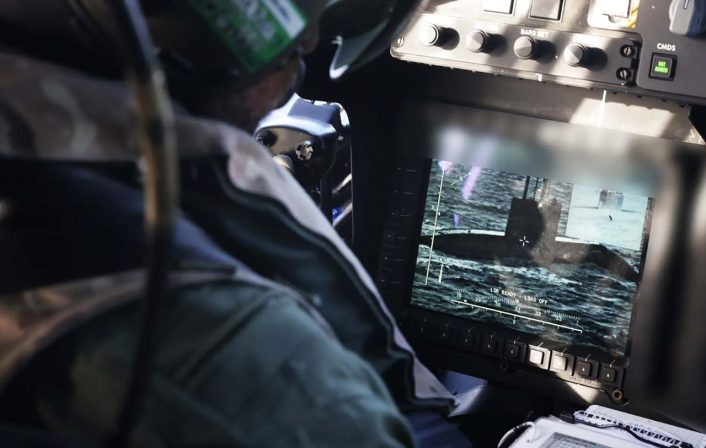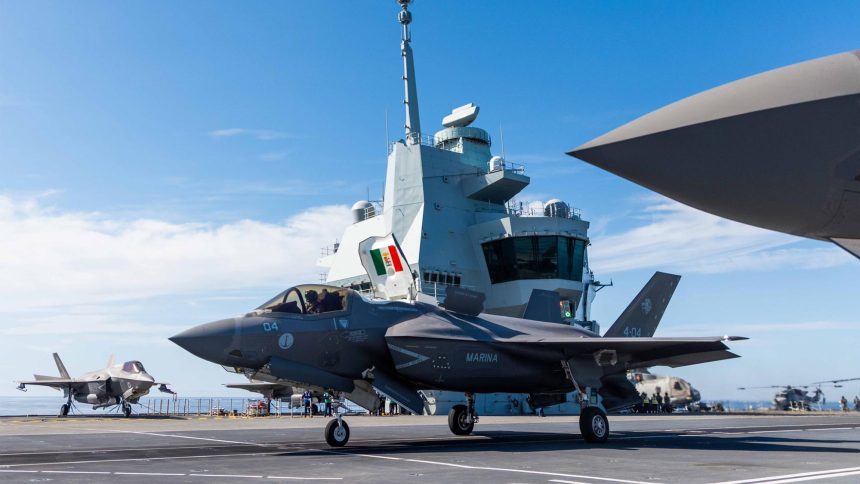Italian F-35B Lightning IIs have landed on HMS Prince of Wales as it heads through the Mediterranean Sea on the mammoth CSG 25 deployment.
Aircraft carriers HMS Prince of Wales and ITS Cavour have rendezvoused as the former travels through the Mediterranean on the Carrier Strike Group 25 deployment, taking a chance to demonstrate the cross-compatibility of the F-35B Lightning II that both the UK and Italy operate as the spearhead of their carrier air wings.
The news was shared via the official Commander, UK Carrier Strike Group (COMUKCSG) X/Twitter account, which also spoke of the welcome afforded to Vice Admiral Aurelio De Carolis, Commander in Chief of the Italian Naval Fleet as he visited the British carrier. An image also shows an Italian F-35B landing on the Cavour, which is carrying a mixed air wing of F-35B Lightning IIs and AV-8B+ Harrier IIs.
Fantastic to welcome Vice Admiral Aurelio De Carolis, Commander in Chief of the @ItalianNavy Fleet.
Truly impressive to see their F35B fighter jets operating from @HMSPWLS during Exercise MedStrike. #UKItaly #CSG25 #MedStrike #ITSCavour #strongerTogether pic.twitter.com/Q5HYuzwTZR
— UK Carrier Strike Group (@COMUKCSG) May 9, 2025
A similar exercise was carried out as HMS Queen Elizabeth passed through the same area in 2021. Later in the deployment, as HMS Prince of Wales nears Japan, there is potential for another cross-decking exercise with Japanese Maritime Self-Defense Force (JMSDF) ships. A British pilot has already landed on JS Kaga during certification trials, although the F-35B used belonged to the Integrated Test Force at Naval Air Station Patuxent River, Maryland.
HMS Prince of Wales and ITS Cavour have both been taking part in NATO’s Exercise Neptune Strike 2-1, which the alliance said tests the ability to maintain control of maritime chokepoints, protect critical undersea infrastructure (CUI), and exercise freedom of navigation. Neptune Strike is led by Naval Striking and Support Forces NATO, headquartered in Oeiras, Portugal, and this year included contributions from Bulgaria, Canada, France, Greece, Italy, Northern Macedonia, Norway, Portugal, Romania, Spain, Türkiye, the United Kingdom and the United States.
.@RFATidespring carrying out a Replenishment at Sea with Portuguese frigate 🇵🇹NRP Bartololeue Dias (attached to the carrier group for exercise Neptune Strike) while conducting concurrent flying operations. #CSG25 pic.twitter.com/s4EdmYOA0Z
— Navy Lookout (@NavyLookout) April 30, 2025
Cavour is one of two ships in the Italian Navy that will field the Marina Militare’s F-35B jets. The other, ITS Trieste, was commissioned in December 2024. Both ships are relatively modern designs, though Cavour is the more senior of the two. It is designed as a dedicated short take-off and vertical landing (STOVL) aircraft carrier, while Trieste, as a landing helicopter (dock) combines its flight deck and ski-jump with a floodable well deck for the deployment of boats, landing craft, and amphibious vehicles. Trieste, notably, shares the dual-island design of the Queen Elizabeth class.
When operating at maximum capacity, both Cavour and Trieste could carry around 20 F-35B jets. Most of the time, actual embarked air wings will be below this figure as operating at maximum capacity lowers the air wing’s efficiency. The much larger HMS Prince of Wales, with a displacement over twice that of Cavour, currently operates an air wing of 18 F-35Bs with the intention of this increasing to 24 jets for a portion of the CSG 25 deployment. At maximum capacity, these carriers could theoretically carry in excess of 36 F-35Bs – again, at the penalty of reduced efficiency.
Maintaining high sortie rates and minimizing the impact on operations by an abundance of parked aircraft was a major factor behind the Queen Elizabeth class’ eventual size, building on experiences from the 1982 Falklands War with HMS Hermes and HMS Invincible.
Breaching the Surface
HMS Astute, the Astute class nuclear-powered attack submarine attached to the Prince of Wales CSG, has made a number of rare appearances above the waves since the task group’s departure. First of all it was spotted by civilian mariners in the English Channel, and more recently off the coast of Portugal. As is common for submarines, Astute also made the transit of the Strait of Gibraltar while surfaced.
Information on the overseas activities of Royal Navy submarines are usually held close to the Ministry of Defence’s chest, so the official release of an image of Astute surfaced alongside the Moroccan FREMM frigate Mohammed VI off the coast of Morocco was an interesting development.

Most significantly, HMS Astute appeared and featured prominently in the assembled carrier strike group fleet for a photo exercise (PHOTEX) before entering the Mediterranean. The same level of press was not afforded to HMS Astute when it deployed previously for the CSG 21 deployment with HMS Queen Elizabeth, with media attention mostly drawn to the submarine’s presence with its occasional port visits.
Putting a nuclear submarine at the forefront of messaging may be deliberate signaling by the Royal Navy and/or UK Government as the undersea theatre becomes increasingly contested. HMS Queen Elizabeth’s aforementioned prior deployment to the Far East generated intense interest from Chinese naval assets both above and below the waves.
Op. Highmast Carrier Strike Group has performed a PHOTEX at the beginning of Ex. Neptune Strike 2025.
HMS Astute, Prince of Wales, Dauntless, ESPS Méndez Núnez, RFA Tideforce, HNoMS Maud, RFA Tidespring, HMS Richmond and HNoMS Roald Amundsen.
(Src/img: https://t.co/RTSpCFJrsb) pic.twitter.com/vTWODMZYai
— UK Forces Tracker (@UKForcesTracker) April 29, 2025
The Astute submarine is one of the CSG’s most valuable and effective anti-submarine and anti-surface assets, and the class is highly regarded worldwide for its exceptional sonar suite and low noise. Although they lack the same level of land attack missile capabilities compared to modern U.S. Navy designs, relying solely on torpedo tube launched Tomahawks rather than a vertical launch system, they are difficult to match in pure submarine warfare.
Additionally, the carrier can call upon its Merlin HM2 anti-submarine helicopters, and anti-submarine frigate escorts to assist in sanitizing the surrounding waters.
Prying Eyes
Well before reaching the Indo-Pacific and facing Chinese intelligence gathering activities, the Prince of Wales CSG has already become a target for foreign espionage. Russian intelligence ship Viktor Leonov approached within visual range of at least part of the group, including Type 45 Destroyer HMS Dauntless, on May 2.

Viktor Leonov is a Project 864 class ship, referred to by NATO forces as the Vishnya class. The class features close-in weapons systems (CIWS) and point defense missiles but are otherwise focused solely on the collection of intelligence via an array of electronic sensors.
The Leonov is one of the most prolific ships of the class, having previously sparked national headlines in the U.S. when it positioned itself around 30 miles off the eastern coast. Two years later, again off the U.S. coast, the Russian ship was accused of unsafe practices by the U.S. Coast Guard.
In 2020, the Royal Navy’s HMS Northumberland encountered the ship off the British coast and commenced counter-intelligence procedures, including the restriction of the use of personal electronic devices, to minimize the amount of valuable information that could be gathered.
A month ago, in April 2025, the Irish Naval Service, Air Corps, and the UK Royal Air Force tracked Viktor Leonov passing through the Irish exclusive economic zone (EEZ). Attempts to hail the Russian ship by Irish naval vessels were left with no response.
The spy ship arrived in the Mediterranean Sea in mid April, transiting the Strait of Gibraltar on Apr. 14, subsequently docking in Algiers, Algeria on Apr. 16. It was noted to sport the infamous “Z” marking on the funnel, which has become a symbol of support for Russia’s invasion of Ukraine.
#RussianNavy Project 864 Vishnya-class intelligence ship Viktor Leonov (CCB 175) docked today at the port of Algiers in what looks like a technical stopover . pic.twitter.com/3Wvdlib3Y3
— O R C A Military 🇩🇿 (@kmldial70) April 16, 2025
After departing Algeria, the Leonov was noted in the Alboran Sea, which is the portion of the Mediterranean immediately east of the Strait of Gibraltar. A U.S. Navy P-8 Poseidon maritime patrol aircraft operated in this area around the time that the Prince of Wales CSG was transiting the strait.
P8 aircraft overflying sail zone of #CSG25 and near to the Russian Navy’s anchorage in the Med off Algiers pic.twitter.com/eV1r4QhhTI
— David Parody 🇬🇮 (@dparody) April 29, 2025
The CSG also had a close encounter with the Russian diesel-electric Kilo class submarine Krasnodar. Krasnodar made a port call to Algiers on Apr. 20 on its way home to Russia.
Satellite images confirm that the Russian submarine 🇷🇺 SSK Krasnodar docked in the port of Algiers between April 20-24. https://t.co/RiSEkynwQ5
— SeaWaves Magazine (@seawaves_mag) April 30, 2025
Departing several days later, the submarine would have crossed paths with the carrier group as each made their journeys in opposite directions. A Wildcat HMA2 helicopter from 815 Naval Air Squadron, attached to the CSG, was used to monitor the submarine as it neared the task group.

By early May, Krasnodar and its support vessel had reached the English Channel where its surface transit was tracked by Royal Navy patrol ship HMS Tyne.









